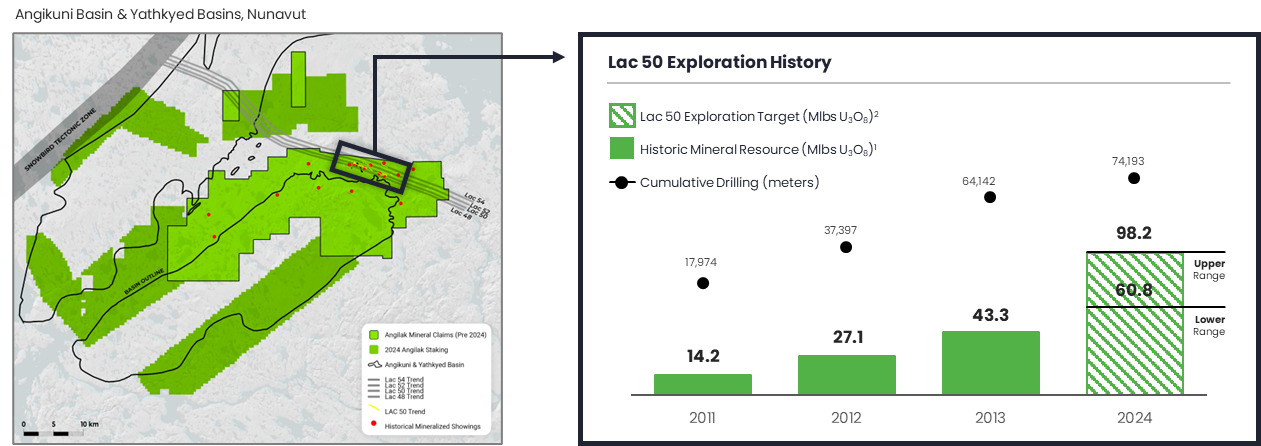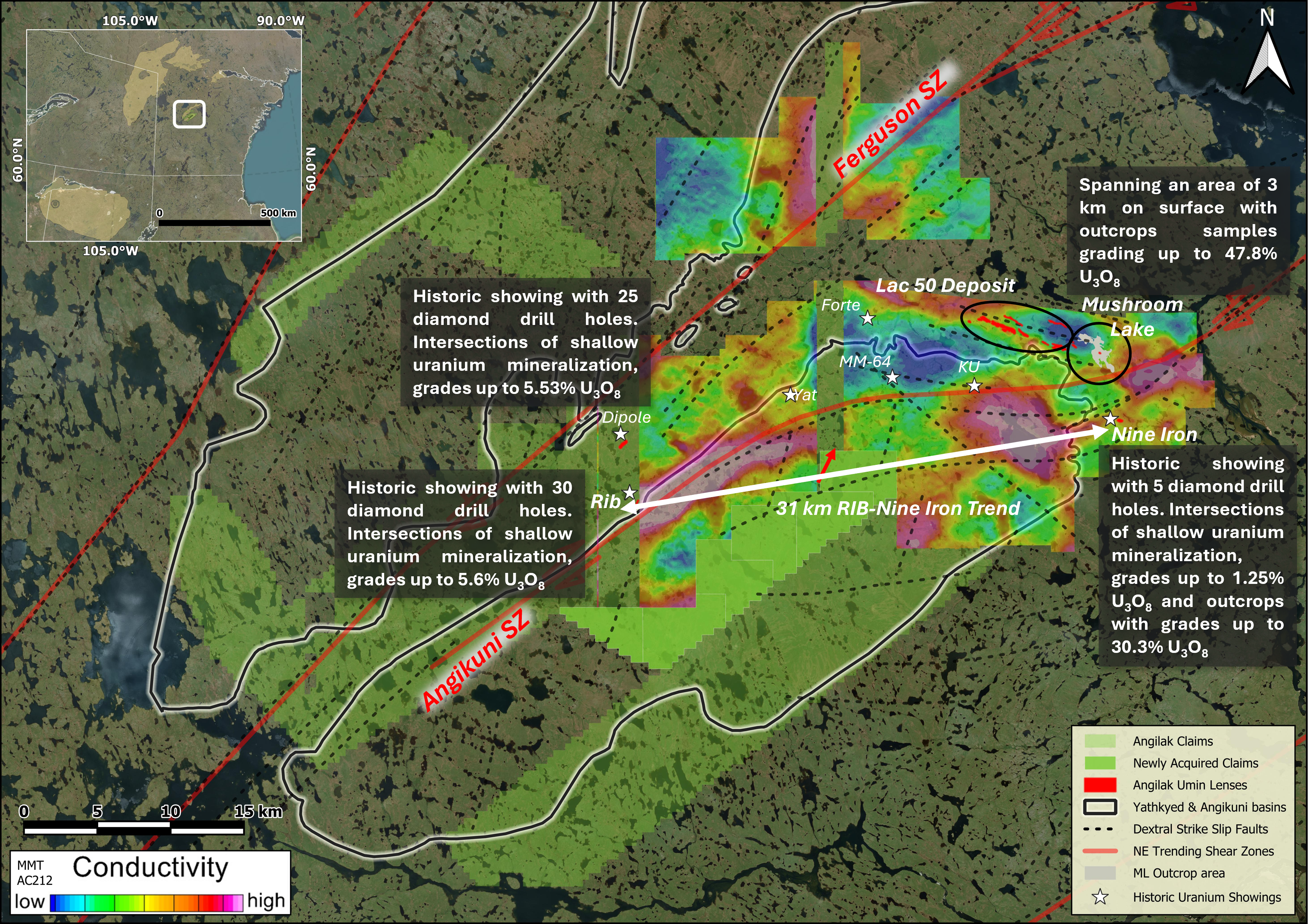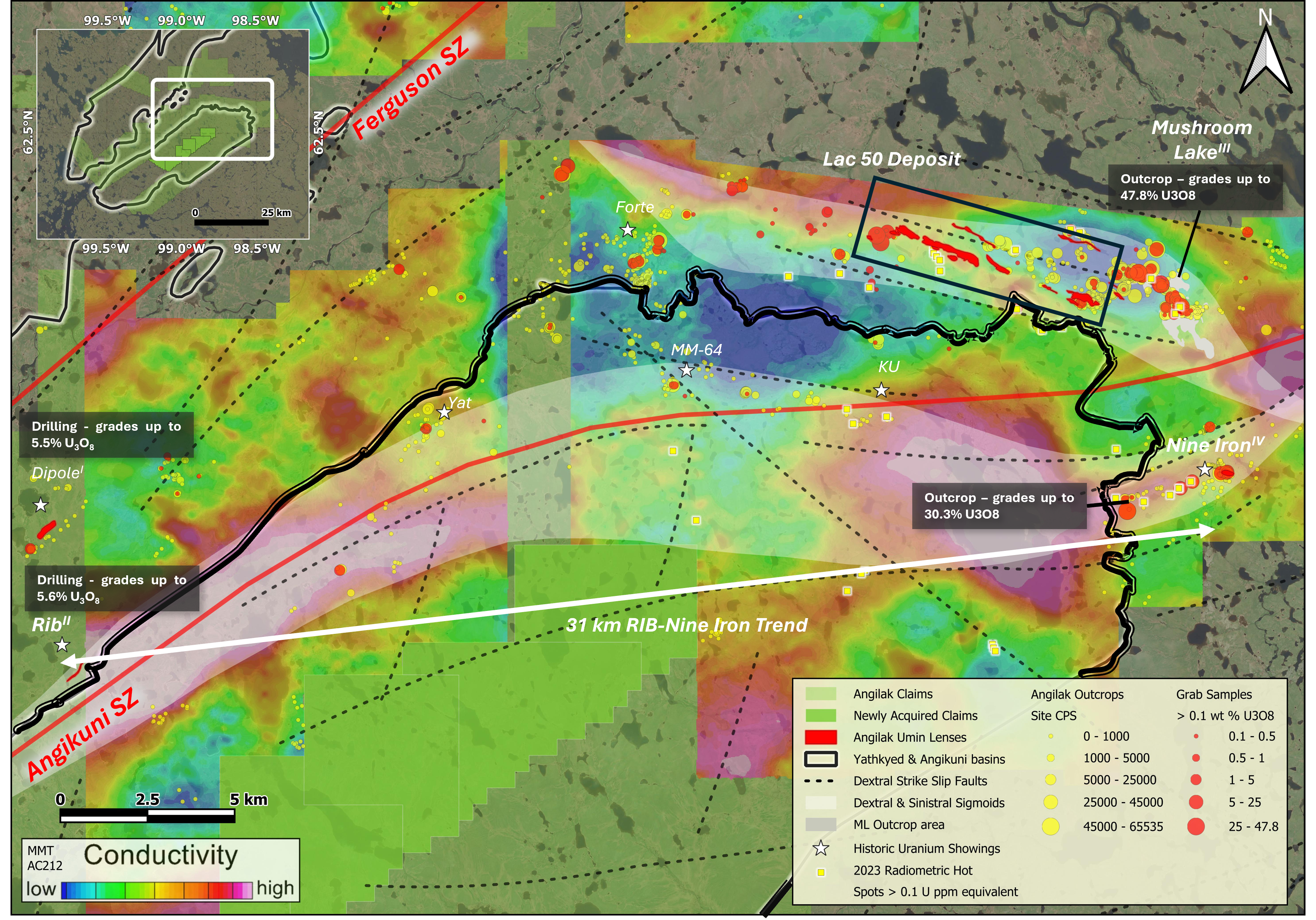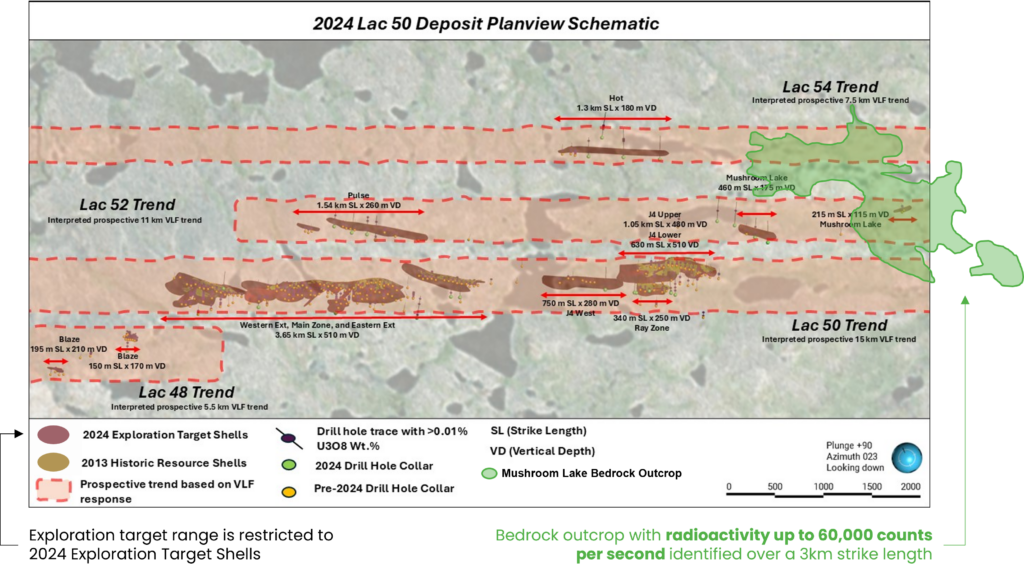
The Angilak Discovery
A high-grade uranium deposit (43.3MM lbs U3O8 historic resource at an average grade of 0.69% U3O8)1 located in Nunavut with district-scale potential
A third-party technical report, released in November 2024 suggested a baseline exploration target for the project ranging between 60.8MM lbs U3O8 and 98.2MM lbs U3O8 at an average grade range of 0.37% U3O8 and 0.48% U3O8 respectively2
The potential quantity and grade of the Lac 50 Exploration Target is conceptual in nature, there has been insufficient exploration to define a mineral resource, and it is uncertain if further exploration will result in the target being delineated as a mineral resource
Project Overview
- Angilak property is located in southern Nunavut and covers 410,611 acres
- The Angilak property hosts a historical mineral resource of 43.3Mlbs U3O8 at an average grade of 0.69% U3O81
- A qualified person has not classified the historical estimates above as current mineral resources or mineral reserves, and ATHA is not treating the historical estimate as current mineral resources or mineral reserves.
- Lac 50 Deposit baseline exploration target ranging between 60.8Mlbs U3O8 and 98.2Mlbs U3O82, with an average grade range between 0.37% and 0.48% U3O8 respectively
- The potential quantity and grade of the above exploration target is conceptual in nature, there has been insufficient exploration to define a mineral resource and it is uncertain if further exploration will result in the target being delineated as a mineral resource
- Home to a 15km long by 3km wide trend – the Lac 50 Trend
- Multiple parallel corridors with confirmed uranium mineralization run parallel to the Lac 50 Trend including, the Lac 48, Lac 52, and Lac 54 Trends
- Subject to +$107.2M of investment since 1975
- One of the highest-grade deposits globally outside of the Athabasca Basin with higher grade than typical Beaverlodge deposits (0.1% – 0.5%)

The Angilak Uranium Project is situated within the Angikuni Basin, approximately 225 km southwest of Baker Lake in the Kivalliq Region of Nunavut. The Project is anchored by the Lac 50 Deposit, in addition there are currently eight named showings containing high-grade uranium, located across the project area. These numerous regional discoveries, both within the Angikuni Basin as well as along its margins – demonstrating many similarities to high-grade uranium discoveries in the Athabasca Basin, Saskatchewan.
Plan Map detailing Lac 50 Deposit location with the Angilak Uranium Project3

2024 Lac 50 Deposit Area and Mapped Mineralized Outcrops3

2024 Angilak Exploration Program Overview
25 diamond drill holes for a total of ~10,051m were completed in 2024 on the Angilak Project. The program successfully completed the following objectives:
- Expand mineralization footprint at the Lac 50 Deposit
- All twelve holes drilled successfully intersected uranium mineralization outside of the historic mineralized domains
- Test parallel structures to the Lac 50 Deposit
- All thirteen holes drilled successfully intersected new lenses of uranium mineralization
- Three prospective trends, all parallel to the Lac 50 Trend were identified
- Surficial sampling, mapping, and regional geophysics
- Program to delineate additional Lac 50 parallel mineralized corridors and identify prospective regional targets
For more information on the 2024 Exploration Program, view our November 25, 2024 press release here. To view the drill hole strip logs, inclusive of detailed assays for all drill holes completed during the 2024 Angilak Exploration Program, click here.

2024 Lac 50 Deposit Planview Schematic

2024 Lac 50 Deposit Long-section Schematic
Summary of November 2024 Angilak Project Technical Report
- The Angilak Project is host to the Lac 50 Uranium Deposit, with a 2013 historical mineral resource estimate of 43.3M lbs at an average grade of 0.69% U3O81
-
- A qualified person has not done sufficient work to classify the historical estimate as current mineral resources or mineral reserves and ATHA is not treating the historical estimate as current mineral resources or mineral reserves
- ATHA retained Mathew Batty, MSc., P.Geo, Owner and Founder of Understood Mineral Resources Ltd. to prepare a Technical Report for the Company’s Angilak Uranium Project, located in Nunavut, Canada
- Batty is a highly experienced resource geologist who was instrumental in the development of NexGen Energy’s Rook I Project. He completed his MSc thesis at the Centre for Computational Geostatistics at the University of Alberta
- The updated 2024 Angilak Project Technical Report summarizes the scientific and technical information (inclusive of assay results from the Company’s 2024 Exploration Program) collected thus far from the Angilak Uranium Project
- Conclusions from the Report – in accordance with the guidelines set forth in the National Instrument NI 43-101 – establishes a baseline Exploration Target Model for resource growth at the Lac 50 Deposit (Table 1). The Exploration Target model is restricted to areas that have been drill tested within the Lac 50 Deposit: comprised of the Lac 48, 50, 52, and 54 mineralized Trends (Figures 2a & 2b)
1Historical Estimates
- The quality and grade of the reported inferred resource in these estimations are uncertain in nature and there has been insufficient exploration to define these inferred resources as an indicated or measured mineral resource, and it is uncertain if further exploration will result in upgrading them to an indicated or measured resource category.
- Contained value metals may not add due to rounding.
- A 0.2% U3O8 cut-off was used.
- The mineral resource estimates contained in this table are considered to be “historical estimates” as defined under NI 43-101 and are not considered by ATHA to be current.
- Reported by ValOre Metals Corp. in a Technical Report entitled “Technical Report and Resource Update For The Angilak Property, Kivalliq Region, Nunavut, Canada”, prepared by Michael Dufresne, M.Sc., P.Geol. of APEX Geosciences, Robert Sim, B.Sc., P.Geo. of SIM Geological Inc. and Bruce Davis, Ph.D., FAusIMM of BD Resource Consulting Inc., dated March 1, 2013.
- As disclosed in the above noted technical report, the historic estimate was prepared under the direction of Robert Sim, P.Geo, with the assistance of Dr. Bruce Davis, FAusIMM, and consists of three-dimensional block models based on geostatistical applications using commercial mine planning software. The project limits area based in the UTM coordinate system (NAD83 Zone14) using nominal block sizes measuring 5x5x5m at Lac Cinquante and 5x3x3 m (LxWxH) at J4. Grade (assay) and geological information is derived from work conducted by Kivalliq during the 2009, 2010, 2011 and 2012 field seasons. A thorough review of all the 2013 resource information and drill data by a Qualified Person , along with the incorporation of subsequent exploration work and results, which includes some drilling around the edges of the historical resource subsequent to the publication of the 2013 technical report, would be required in order to verify the Angilak Property historical estimate as a current mineral resource.
- The historical mineral resource estimate was calculated in accordance with NI 43-101 and CIM standards at the time of publication and predates the current CIM Definition Standards for Mineral Resources and Mineral Reserves (May, 2014) and CIM Estimation of Mineral Resources & Mineral Reserves Best Practices Guidelines (November, 2019).
2Exploration Target
- Understood Mineral Resources Ltd. (UMR) completed a NI 43-101 technical report titled “Technical Report on the Angilak Property, Nunavut, Canada” with an effective date of November 25, 2024, authored by Matt Batty, MSc, P. Geo, who is a “qualified person” under NI 43-101.
- The QP provided ranges for potential uranium quantity and grade as a target for further exploration on the Lac 50 Deposit using the available verified diamond drillhole data, including the 2024 drill program results. The ranges were derived from conceptual vein wireframes, drill core assays, grade interpolation, and applied uncertainty bandwidths. The stated potential quantity and grade is conceptual in nature, and there has not been sufficient exploration to define a mineral resource, and it is uncertain if further exploration will result in the target being delineated as a mineral resource. The exploration target encompasses the deposit area previously included within the hisotircal mineral resource.
3Historical Drilling and Outcrop Samples
Certain noted technical information provided herein has been derived exclusively and without independent verification from the following reports. Such information is historical in nature and is not considered by the Company to be current. In each case, the reliability of the historical information is considered reasonable by the Company. The historical information provides an indication of the exploration potential of the properties but may not be representative of expected results. Readers should read the entirety of such noted reports to fully understand the nature of the information referenced herein. Samples, including, without limitation, outcrop samples, by their nature, are selective in nature and significant variations may be seen from sample to sample. Accordingly, sample information may not be representative of the true underlying mineralization.
References for Historic Diamond Drilling Results
- Papish, N.Z. 1978. 1978 Diamond Drill Report, Keewatin District N.W.T. Yathkyed Lake Area. Noranda Exploration company Assessment Report. March 6, 1979. A copy of such report is available on the website of the Government of Nunavut at https://nunavutgeoscience.ca/en/.
- Dufresne, M.B., Sim, R. and Davis B., (2013). Technical report And Resource Update for the Angilak Project, Kivalliq Region, Nunavut. Technical Report prepared on behalf of Kivalliq Energy Corporation, March 1st, 2013. A copy of such report is available on the SEDAR+ profile of Kivalliq Energy Corporation at www.sedarplus.com.
- Dufresne, M.B. and Schoeman, P. (2023). Technical report on the Angilak Project, Kivalliq Region, Nunavut. Technical Report prepared on behalf of ATHA Energy Corp. and Labrador Uranium Inc., January 31st, 2024. A copy of such report is available on the SEDAR+ profile of the Company at www.sedarplus.com.
References for Historic Surficial Sampling
- Ward, j., Maynes, A., McNie, E., Forbes, A. and Stacey, J. 2012. Report on 2010 and 2011 Exploration Activity on Kivalliq Corporation’s Angilak IOCG-Uranium Property, Keewatin District, Nunavut. Kivalliq Energy Corporation Assessment Report. A copy of such report is available on the website of the Government of Nunavut at https://nunavutgeoscience.ca/en/.
- Dufresne, M.B., Sim, R. and Davis B., (2013). Technical report And Resource Update for the Angilak Project, Kivalliq Region, Nunavut. Technical Report prepared on behalf of Kivalliq Energy Corporation, March 1st, 2013. copy of such report is available on the SEDAR+ profile of Kivalliq Energy Corporation at www.sedarplus.com
- Dufresne, M.B. and Schoeman, P. (2023). Technical report on the Angilak Project, Kivalliq Region, Nunavut. Technical Report prepared on behalf of ATHA Energy Corp. and Labrador Uranium Inc., January 31, 2024. A copy of such report is available on the SEDAR+ profile of the Company at www.sedarplus.com
ATHA Energy’s Asset Portfolio
A comprehensive asset portfolio with maximized torque to exploration upside.
>7MM Acres of Exploration Land
3.8MM acres of land within the Athabasca Basin, 3.1MM acres of land in the Thelon Basin, and 399k acres in the Central Mineral Belt
The Gemini Discovery
A high grade, basement hosted discovery along a mineralized trend
CMB
Discovery
CMB discoveries (14.5MM lbs U3O8 historic resource at 0.037% U3O8)† in Labrador with district-scale potential
Upside to Major Developers
10% carried interest on key parts of NexGen and IsoEnergy land, which is actively being explored
†A Qualified Person has not done sufficient work to classify the historical estimates as current mineral resources or mineral reserves and ATHA is not treating the historical estimates as current mineral resources or mineral reserves.

Sign Up for Updates from ATHA Energy Corp
Sign up to receive the latest ATHA Energy Corp. updates directly to your inbox.
